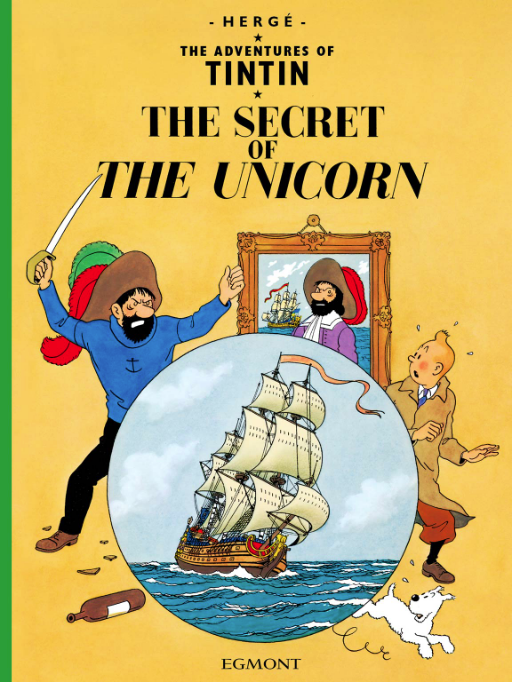

NB – This is a review of the Egmont A4 sized paperback (and will stand for the hardback version too), but most emphatically not the newer, smaller reprint.
For instalments 11 and 12 of the Tintin sagas we get the first proper double bill, and on the classic theme of a treasure hunt. Having acquired a model ship for his pal Capt. Haddock, Tintin and the old sea dog discover that it’s a model of the Capt.’s ancestor Sir Francis Haddock’s ship. Amidst a spate of pick-pocketing and burglary it soon becomes apparent that more than one model ship exists, and that there are cryptic clues pointing towards possible treasure.
Haddock is on fine form, and the whole lengthy episode, occupying approx. 1/4 of the book, where he relates and enacts his ancestors’ tale for Tintin is priceless, full of visual and verbal fun. Part of the humour revolves around Haddock’s alcohol consumption during the tale-telling, and Tintin’s attempts to rein in his penchant for the bottle, but mostly it’s just the action itself. Beautifully scripted and drawn, it’s pure pleasure to read. Wonderful stuff.
This is also one of the books where Hergé’s diligent research is most apparent: he clearly wanted the historical naval scenes, and especially the Unicorn, to be convincing, and they are. To achieve this he not only did thorough research, but also had a model of the Unicorn built. Studying the frames with this ship reveal it really is a beautifully rendered thing. Capt. Haddock’s colourful vocabulary is shown to run in the family, and Hergé’s ingenious way of getting around the infamously broad language of sailors is thereby amplified. As a kid I used to love looking up the odd and unusual words in a dictionary.
The villainous antique dealing Bird brothers go to far more dastardly lengths than the average bow-tie wearing fops we see on TV to get what they want. It’s thanks to them that we’re introduced to Marlinspike Hall and Nestor, where Tintin, as an unwitting and unwilling guest, is forced to do some improvised DIY, whilst Snowy get a few brief cameos as the doting hound sniffing out his abducted master’s whereabouts and coming to his rescue.
Running throughout this adventure, the pickpocket theme eventually proves to be more than just a gag, but pivotal to Tintin and Haddock’s quest, but I won’t give any more away. This is a fabulous fun packed Tintin classic, even the way it ends, with Tintin addressing the reader directly to commend the sequel to them is just charming. I loved this as a young boy, and I love it just as much now, many, many moons (too many, alas!) later.
